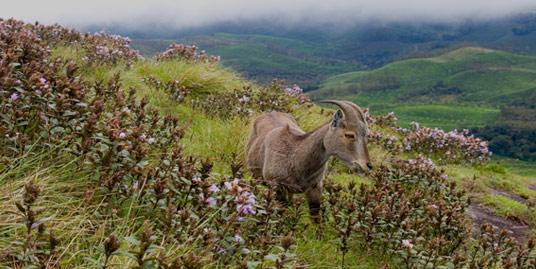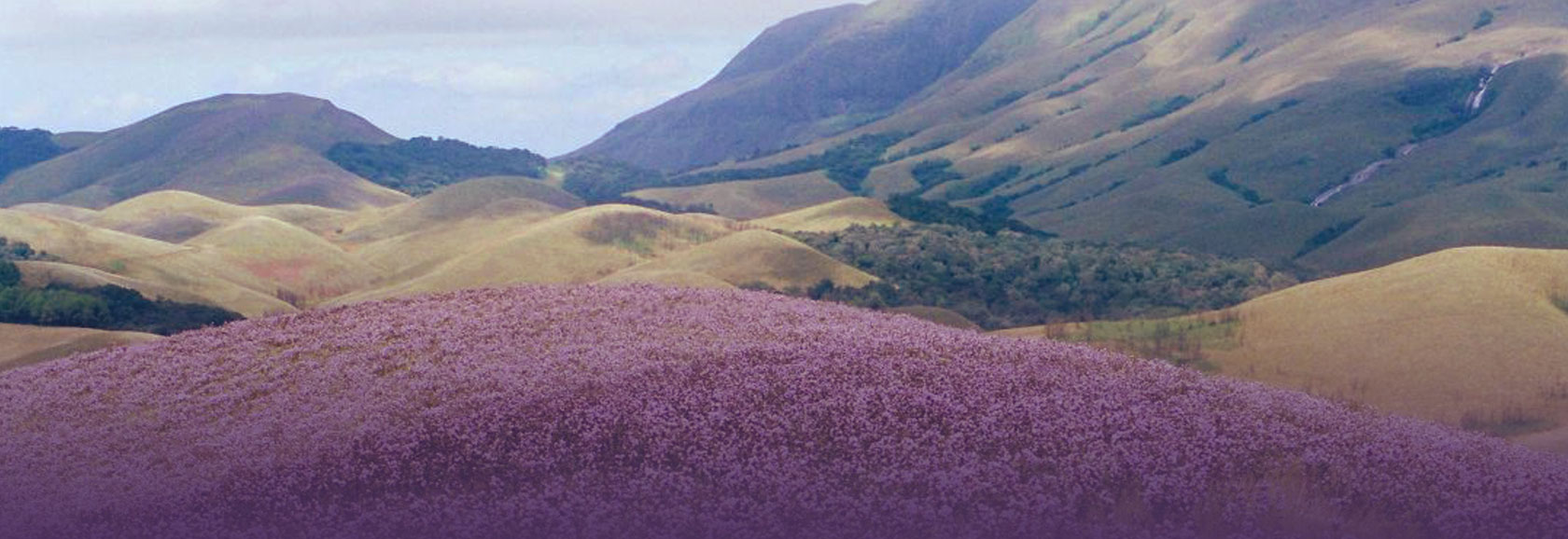

Neelakurinji – the bloom of a unique ecosystem
The bloom makes the mountains blue; We make the landscape brown?
-E Kunhikrishnan


The bloom makes the mountains blue; We make the landscape brown?
-E Kunhikrishnan

E Kunhikrishnan, Associate Professor (Rtd.)
Department of Zoology, University College, Thiruvananthapuram
The High Altitudes of the Western Ghats is a world apart with its endemic flora and fauna, cloistered in the alpine climate on the high plateaus and peaks. A peculiar kind of ecosystem known as the shola – grasslands evolved on the altitudes above 1500 meters in southern Western Ghats. H. G. Champion and S. K. Seth, while classifying the phytogeographic zones in the Indian subcontinent, identified that the southern montane wet temperate forest and grasslands exist in the high altitudes of southern Western Ghats. Sholas are montane stunted evergreen forests of high density with its peculiar species combination. In the sholas, the trees are characterised by crooked branches, thickly laden with moss, pteridophytes, lichens, orchids and other epiphytes making the system highly hygroscopic. The shola trees have interlocking branches to withstand the high velocity winds blowing from the west during the monsoon. The grasslands are open meadows in the misty mountain tops and valleys, studded with patches of bushes and sholas, which are usually seen sheltered in folds of the rolling plateau and at the heads of streams. The name “shola” might have come from the word “chola”, which has two meanings- shade and spring. The sholas in the high altitudes justify both meanings; the thick canopy completely filters the sun and invariably a spring is born in the shola. The high altitudes in the southern Western Ghats, not far from the equator, gives a latitudinal effect imparting an alpine climate, sheltering many species and close relatives of flora and fauna that thrive in the Himalayas and in the Indo- Malayan realm. In the southern Western Ghats, extensive shola – grasslands vegetation features on the Anamalais, Nilgiris and Palnis (Kodaikanal), where most of the peaks above 2000m from the sea level exist. The Anamudi, in the Anamalais, is the highest peak in the Western Ghats is at 2695 m above the sea level. It is the highest peak south to the Himalayan ranges. Many endemic plant and animal species have evolved and remained confined to this unique ecological regime. Some scientists rightly referred to these tropical montane areas as “islands in the sky”, since the montane habitats are widely separated by low-lying areas which are inhospitable to the species adapted to the high altitudes. The Nilgiri tahr (Nilgiritragus hylocrius), the only mountain goat in south India is largely an animal of the shola- grasslands with rocky cliffs. All its relatives are mainly seen in the higher reaches of the Himalayas.
The sholas and the grasslands harbour a large variety of alpine plant families and species. Large congregations of many species of Strobilanthes are very special to the sholas and grasslands. Strobilanthes belongs to the plant family Acanthaceae. Barleria is another common genus in this family, with showy flowers. Strobilanthes, a large genus of interesting forest shrubs with their periodical flowering in the montane grasslands and sholas has been attracting the attention of many naturalists from early 19th century itself. According to the Flora of British India, there are at least 146 fully described Strobilanthes species in the Indian region. Another great botanist of the colonial era, James Sykes Gamble described 46 species in his book Flora of Madras Presidency. Majority of the Strobilanthes are gregarious and flower in definite periodic intervals. The periodicity of flowering varies from species to species. The early information on the flowering and periodicities of Strobilathes in the Anamalais, Nilgiris and Palnis (Pulneys) is available in the notes and articles published in journals like Indian Forester and Journal of Bombay Natural History Society, by various naturalists and taxonomists. Strobilanthes kunthianusm (Phlebophyllem kunthianun) flowers gregariously once in 12 years turning the entire grasslands in the misty mountains of Nilgiris, Anamalais and Palnis into a blue sea. The Nilgiris (meaning “blue mountains”) got its name from this periodic phenomenon. The plants will flower only once and then wilt and dry up shedding seeds, giving way to the next generation of plants to grow up and repeat the phenomenon after 12 years. Such plants are known as monocarpic. Bamboos are known for their monocarpic nature.
Various Strobilanthes species found in Nilgiris ...more
There are many species of shola kurinji (locally k ...more
The first European settlers in Nilgiris recorded t ...more
The British planters who discovered new pastures i ...more
The present situation in Munnar is not giving any ...more